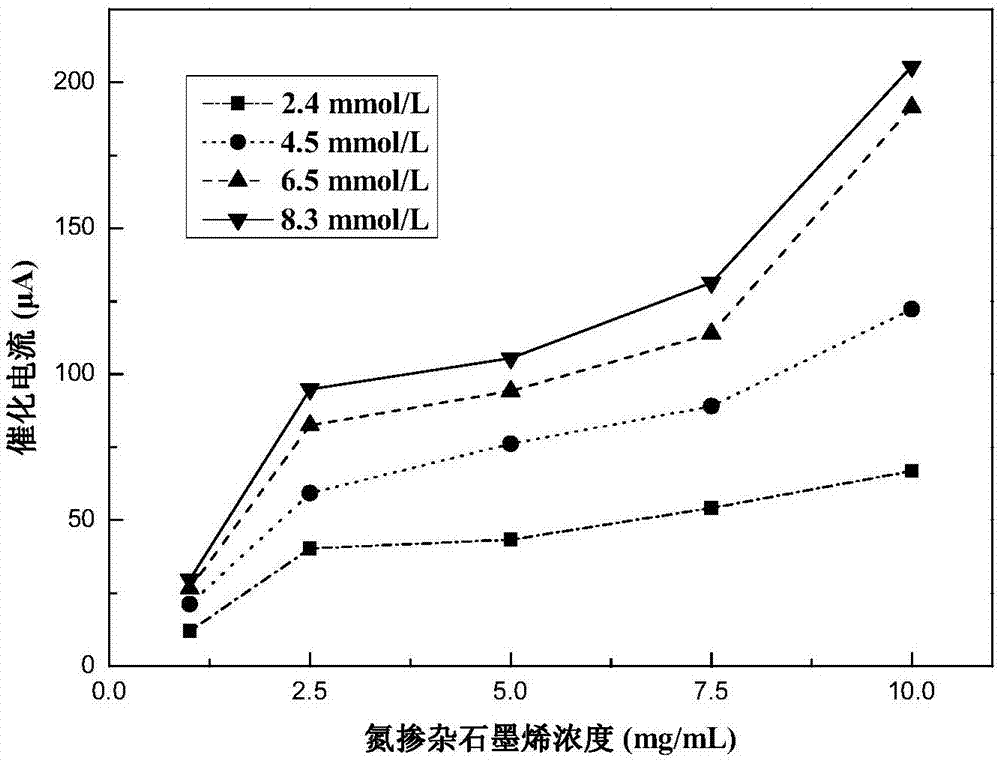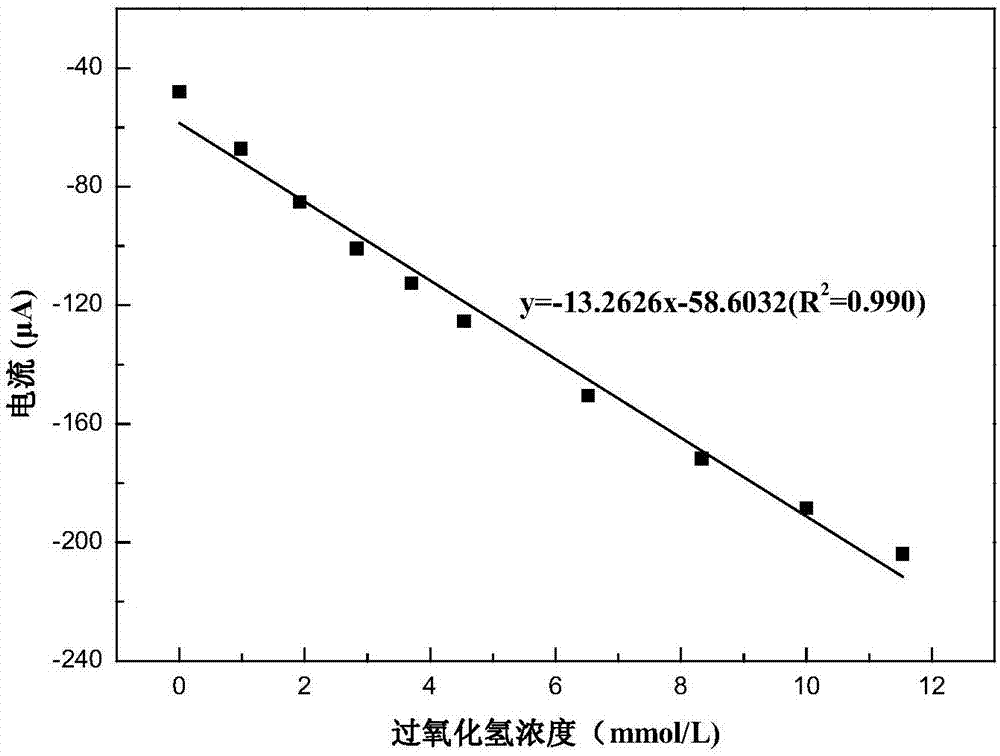Non-enzyme sensor based on nitrogen-doped graphene and preparation method and application thereof
A nitrogen-doped graphene and enzyme sensor technology is applied in the field of biosensors to achieve the effects of improving reaction speed, stable performance and good selectivity
- Summary
- Abstract
- Description
- Claims
- Application Information
AI Technical Summary
Problems solved by technology
Method used
Image
Examples
Embodiment 1
[0035] A method for preparing an enzyme-free biosensor based on nitrogen-doped graphene in this embodiment, the specific preparation steps are as follows:
[0036] (1) The glassy carbon electrode with a diameter of 3 mm is sequentially filled with Al with a diameter of 0.3 μm and 0.05 μm 2 o 3 The powder was polished into a mirror surface, rinsed with distilled water, and then ultrasonically cleaned in absolute ethanol and distilled water for 1 min, and then the treated glassy carbon electrode was placed in 0.5mol / L H 2 SO 4 In the solution, the electrochemical redox is carried out at the potential window of -0.3-1.5V, the glassy carbon electrode is activated and the residue on the electrode surface is removed.
[0037] (2) Take 100mg of graphite oxide in a beaker, add 50mL of deionized water and ultrasonically strip it for 4h, then add 6.25mL of FeCl3 ·6H 2 O solution and 235 μL of pyrrole monomer were placed in the reactor at 40°C for 1 hour and stirred at a constant temp...
Embodiment 2
[0044] A method for preparing an enzyme-free biosensor based on nitrogen-doped graphene in this embodiment, the specific preparation steps are as follows:
[0045] (1) The glassy carbon electrode with a diameter of 3 mm is sequentially filled with Al with a diameter of 0.3 μm and 0.05 μm 2 o 3 The powder was polished into a mirror surface, rinsed with distilled water, and then ultrasonically cleaned in absolute ethanol and distilled water for 1 min, and then the treated glassy carbon electrode was placed in 0.5mol / L H 2 SO 4 In the solution, the electrochemical redox is carried out at the potential window of -0.3-1.5V, the glassy carbon electrode is activated and the residue on the electrode surface is removed.
[0046] (2) Take 100mg of graphite oxide in a beaker, add 50mL of deionized water and ultrasonically strip it for 4h, then add 6.25mL of FeCl 3 ·6H 2 O solution and 235 μL of pyrrole monomer were placed in the reactor at 40°C for 1 hour and stirred at a constant te...
Embodiment 3
[0053] A method for preparing an enzyme-free biosensor based on nitrogen-doped graphene in this embodiment, the specific preparation steps are as follows:
[0054] (1) The glassy carbon electrode with a diameter of 3 mm is sequentially filled with Al with a diameter of 0.3 μm and 0.05 μm 2 o 3 The powder was polished into a mirror surface, rinsed with distilled water, and then ultrasonically cleaned in absolute ethanol and distilled water for 1 min, and then the treated glassy carbon electrode was placed in 0.5mol / L H 2 SO 4 In the solution, the electrochemical redox is carried out at the potential window of -0.3-1.5V, the glassy carbon electrode is activated and the residue on the electrode surface is removed.
[0055] (2) Take 100mg of graphite oxide in a beaker, add 50mL of deionized water and ultrasonically strip it for 4h, then add 6.25mL of FeCl 3 ·6H 2 O solution and 235 μL of pyrrole monomer were placed in the reactor at 40°C for 1 hour and stirred at a constant te...
PUM
| Property | Measurement | Unit |
|---|---|---|
| concentration | aaaaa | aaaaa |
Abstract
Description
Claims
Application Information
 Login to View More
Login to View More - R&D
- Intellectual Property
- Life Sciences
- Materials
- Tech Scout
- Unparalleled Data Quality
- Higher Quality Content
- 60% Fewer Hallucinations
Browse by: Latest US Patents, China's latest patents, Technical Efficacy Thesaurus, Application Domain, Technology Topic, Popular Technical Reports.
© 2025 PatSnap. All rights reserved.Legal|Privacy policy|Modern Slavery Act Transparency Statement|Sitemap|About US| Contact US: help@patsnap.com



